Marine Litter: A Crisis for Oceans and Humanity
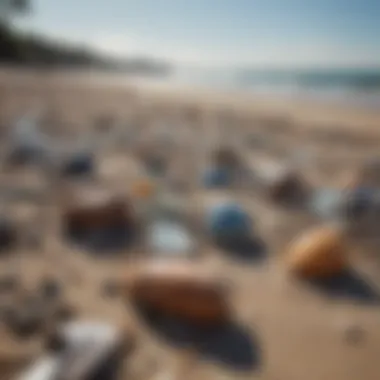
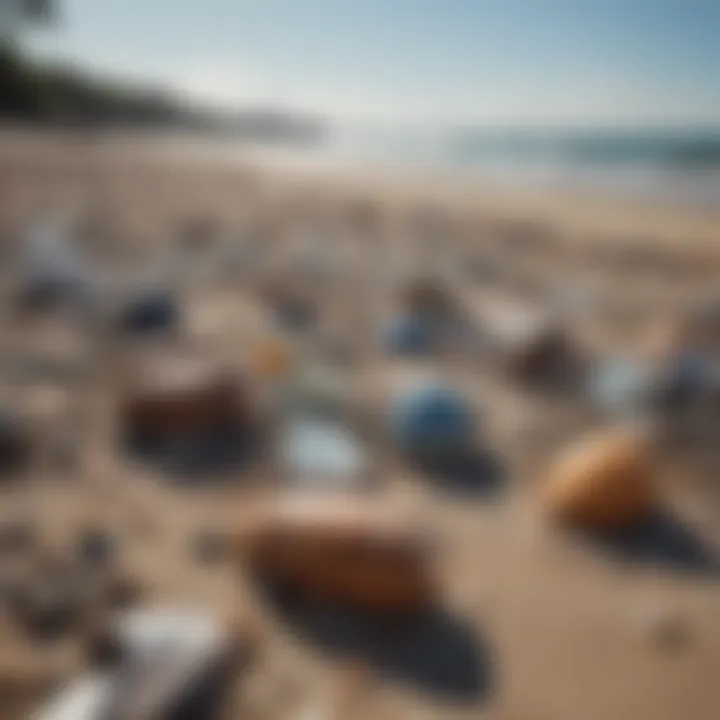
Intro
Marine litter is not just an environmental issue; it's a full-blown crisis that lurks quietly yet impacts us all. Picture this: oceans teeming with life, colorful coral reefs adorned with fish, and the gentle sway of kelp forests. But beneath this idyllic surface lies a different reality, a growing threat that manifests through various forms of litter. This isn’t merely a concern for marine creatures but a vital issue that spirals up to affect human health and coastal communities.
From plastic bottles to abandoned fishing gear, these items don’t just float. They break down into microplastics, making their way into the food chain. Marine litter has become a multifaceted problem that demands our attention. Understanding its sources and the ways it entangles with ecosystems is crucial. This article aims to piece together the puzzle, shedding light on how we arrived at this juncture and what it means for future generations.
Research Overview
Summary of Key Findings
The implications of marine litter are vast and profound. Some of the key findings of various studies underline how:
- Over eight million tons of plastic enter the oceans each year.
- Marine life, from plankton to whales, is affected by ingestion of plastics.
- Coastal communities suffer economically and socially due to decreased tourism and health risks.
These findings point toward not just a call for action but a necessity to rethink our relationship with plastic and waste disposal.
Background and Context
Historically, human activity has always had a hand in shaping nature, often with detrimental effects. Since the mid-20th century, the surge in single-use plastics has woven a complex narrative of convenience versus environmental stewardship. The development of materials like polystyrene and polyethylene has led to significant changes in consumer habits.
As waste disposal methods evolved, many items ended up discarded in environments that couldn't accommodate them. Landfills became overflowing, and waterways turned into pathways for debris heading for the seas. It's imperative to grasp this context to truly understand the current state of marine debris and its long-term impacts.
"In today’s world, littered shores and plastic-filled waters are not just the unfortunate byproducts of consumption, they are harbingers of change—if we allow them to be."
Methodology
Experimental Design
To understand the scope of marine litter, researchers employ various study designs, often employing a combination of field assessments and laboratory analyses. Some projects involve direct sampling from beaches or oceanic gyres, while others analyze the ecological impacts through controlled experiments in marine facilities.
Data Collection Techniques
Data collection regarding marine debris often utilizes:
- Visual surveys: Observing and cataloging debris on beaches.
- Buoy-based studies: Tracking movements of litter in ocean currents.
- Laboratory analyses: Identifying types of plastics and their degradation rates.
The combination of these techniques allows scholars to grasp the scope of the problem in its entirety, informing the potential for solutions.
Prolusion to Marine Litter
The issue of marine litter is not just a fleeting concern but a persistent crisis that hangs over our oceans like a thick fog. As we dive into this topic, it becomes clear that understanding marine litter is not only crucial for the health of our ecosystems but also for our very survival. Every piece of litter washed ashore tells a story of human neglect and urgency, shouting warnings that we can no longer afford to ignore. Marine litter can disrupt the balance of marine environments, endanger wildlife, and pose significant threats to human health.
Definition and Scope
Marine litter refers to any persistent, manufactured or processed solid material discarded, disposed of, or abandoned in the marine environment. This might range from plastic bags floating on the surface to lost fishing nets tangled in coral reefs. A substantial portion of this debris originates from land-based sources, while others are discarded directly into oceans.
The scope of this issue is indeed vast; research estimates billions of tons of waste end up in marine ecosystems annually. Microplastics – tiny particles less than five millimeters in size – account for a significant share. These little devils not only harm marine life through ingestion but also accumulate in the food chain, ultimately threatening human health as well.
Historical Context
To comprehend the present situation, we must trace the roots back to how this crisis unfolded. Historically, marine litter began its trajectory in the mid-20th century, coinciding with the post-war boom in plastic production. What was initially hailed as a breakthrough in convenience slowly morphed into a foe for our oceans. In the early days, litter was predominantly organic waste, as societies relied on natural materials. However, as the decades rolled by, the shift to synthetic products took off, leading to staggering numbers of non-biodegradable items.
From the 1970s onward, awareness began to grow about the environmental impacts of marine litter, leading to various cleanup initiatives. Yet, despite these efforts, the problem kept getting worse, highlighting an uncomfortable truth: addressing marine litter requires more than just cleanup. It demands systemic changes in waste management, production, and consumer behavior at a global level. The early responses were insufficient and often reactive rather than proactive, focusing on alleviating the symptoms rather than tackling the root cause.
It is essential for students, researchers, and professionals alike to recognize how history shapes our current understanding of marine litter. Contextualizing this issue within a larger narrative not only helps in appreciating the magnitude of the crisis but also sets the stage for innovative solutions and collaborative efforts moving forward.
Types of Marine Litter
Marine litter comes in various forms, each with unique characteristics and challenges it presents. Understanding the types is crucial because it shapes the approaches we take in addressing the problem and allows for targeted solutions that can be more effective.
Plastic Debris
In this day and age, plastic debris represents one of the most significant contributors to marine litter. It plays a role that cannot be overlooked, given its omnipresence in our daily lives and the subsequently dire effects on the marine environment. Plastic comes in various shapes and sizes, affecting not just marine ecosystems but also human health down the line.
Microplastics
Microplastics, those tiny plastic particles smaller than five millimeters, are perhaps the most alarming aspect of plastic debris. They result from the breakdown of larger plastic items or are manufactured in small sizes for cosmetic or industrial uses. Their small size allows them to infiltrate even the most remote marine environments.
The key characteristic of microplastics is their ability to absorb toxic chemicals from the water, which later gets ingested by marine organisms. This contributes to a broader goal of understanding the health impacts on marine life and ocean ecosystems. A double-edged sword for this issue, while they often escape pre-consumer regulation due to their size, they pose significant risks once they enter the marine environment.
The unique feature of microplastics is their indestructibility in marine settings. Unlike organic materials that can decompose over time, microplastics persist for hundreds of years. This durability brings with it a long-term problem: they contribute to pollution and affect marine life and ecosystems, which is a drawback to address throughout this article.
Macroplastics
Macroplastics refer to any plastic item larger than five millimeters, including bags, bottles, and fishing gear. Their presence in the ocean is emblematic of larger consumption patterns in society. They block sunlight from entering the water, hindering the growth of aquatic plants, and impacting the food chain.
Highlighted as a large-scale issue, macroplastics are often transported to the ocean through improper waste management practices and urban runoff. Their prevalence is a significant focus of discussions around marine litter, simply because they are often visible and easily identifiable.
The unique feature of macroplastics is their potential to entangle marine life, leading to injuries and fatalities in animals like seabirds and turtles. Their sheer size makes them a hazard for large aquatic animals who do not distinguish between food and debris. The challenge lies in both the immediate impacts on wildlife and the long-term effects on ecosystem health, making them a notable subject for this discourse.
Single-Use Plastics
Single-use plastics are yet another notorious member of the plastic family, designed to be used once before being discarded. Think plastic straws, utensils, and shopping bags. Their convenience is an aspect society often celebrates but at a significant environmental cost.
What stands out about single-use plastics is their contribution to pollution. These items make up a hefty percentage of plastic waste in oceans and coastlines. They degrade into smaller plastics over time, exacerbating the microplastic problem.
However, their easy availability often overshadows the environmental ramifications, and the unique feature that makes them particularly harmful is their short lifespan leading to a long-term waste problem. Addressing single-use plastics in this article points a critical lens at consumer habits, which must shift towards reusable alternatives if we hope to combat marine litter effectively.
Organic Materials
Organic materials can often be overlooked when discussing marine litter, but they play an important role in understanding the full scope of the problem. Their presence is often the result of natural processes or human activities.
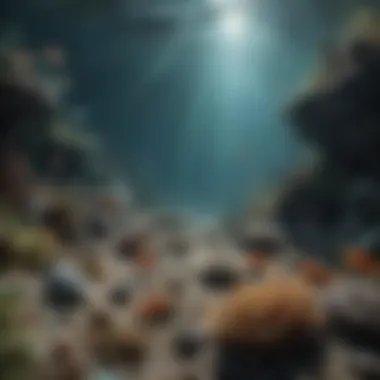
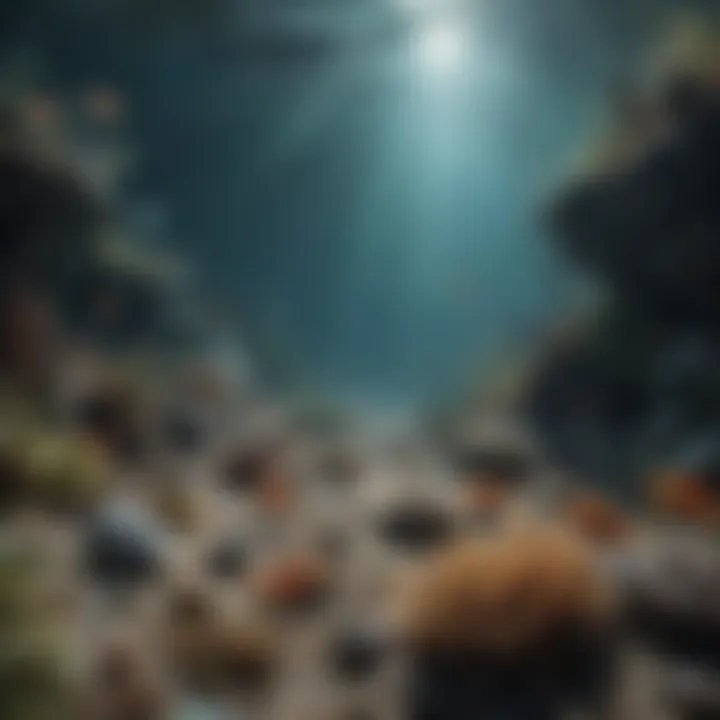
Natural Waste
Natural waste, such as leaves or biodegradable items, may seem harmless, but it can disrupt marine ecosystems. When large amounts wash into the ocean, they can deplete oxygen levels, impacting marine life. The key characteristic of natural waste is its duality; while it is often biodegradable, if improperly managed, it can become another form of pollution.
The unique feature here is the interaction with man-made debris. Natural waste can accumulate with plastics, creating more complex litter patches that can confuse marine life. Therefore, while considered less harmful, discussing natural waste in this context adds nuance to the conversation around what constitutes marine litter.
Fishing Gear
Fishing gear is a significant component of organic materials in marine litter, comprising items like nets and lines that are often discarded or lost after use. Their durability and intended purpose make them particularly dangerous in marine environments.
With fishing gear, the key characteristic is its entanglement risk to marine animals. Ghost fishing, when abandoned nets continue to trap fish and other animals, causes prolonged suffering for marine life. Thus, addressing fishing gear in our exploration of marine litter is essential, as it underscores human activity's unintended consequences on the ecosystem.
Chemical Waste
Lastly, but certainly not least, we must consider chemical waste. This broad category consists of harmful substances that can leach into ocean waters, often coming from industrial practices.
Heavy Metals
Heavy metals such as mercury or lead pose critical risks to both marine and human life. These substances accumulate in marine organisms over time, leading to serious health concerns, including neurological damage. The key characteristic of heavy metals is their persistence in the environment, not easily breaking down like organic materials.
The unique feature of heavy metals is their capacity for bioaccumulation, which means that as these metals move up the food chain, their concentration increases, posing risks to top predators, including humans. Anchoring the discussion in a broader analysis of marine litter, these substances emphasize the intertwined relationship between pollution and health, stressing the need for cleanup initiatives.
Industrial Discharges
Industrial discharges represent another concerning aspect of chemical waste. Factories discharging unregulated toxins have been a running issue for decades, directly impacting marine health. The key characteristic of these discharges is their often invisible impact, affecting only after time has passed.
This article spotlights the need for stricter regulations on industrial practices, showcasing the unique feature of these discharges: they often trace back to human activity, making them a primary target for future legislative efforts.
Through this granulated approach to discussing types of marine litter, we can begin to grasp the multifaceted challenges faced by our oceans—each type contributing to a larger narrative that calls for urgent action.
Sources of Marine Litter
Understanding the sources of marine litter is crucial to tackle this pervasive issue effectively. Marine litter doesn’t materialize out of nowhere; it stems from human activity both on land and in the ocean itself. By identifying and analyzing these sources, we gain insights into preventative measures and responsible practices that can significantly reduce the flow of debris entering our oceans. In this section, we will explore the various sources of marine litter, breaking them down into land-based and ocean-based categories.
Land-Based Sources
Land-based sources of marine litter play a significant role in the overall contamination of coastal and marine environments. These include urban runoff, waste management failures, and tourism-related factors. Each of these elements contributes uniquely to the problem, reflecting a range of human behaviors and infrastructural issues.
Urban Runoff
Urban runoff refers to the excess water that flows over pavement and other impermeable surfaces during and after rainfall. As this water travels, it picks up a medley of pollutants, including plastics, oils, and chemicals, before draining into rivers, lakes, or directly into the ocean. One key characteristic of urban runoff is its efficiency in transporting litter from various areas directly into our waterways.
This topic is beneficial for our article because it illustrates a common problem in highly developed areas. The unique feature of urban runoff lies in its ability to coalesce different types of debris from diverse sources—ranging from discarded food wrappers to construction materials. While effective at showcasing the link between urban infrastructure and marine health, it also highlights significant disadvantages: this runoff significantly alters the water quality and can lead to the death of aquatic life.
Waste Management Failures
Waste management failures encompass a broad range of issues—such as inadequate recycling programs, insufficient landfill spaces, and the improper disposal of waste. Often, these problems lead to litter finding its way into coastal regions. The key characteristic of waste management failures is their manifest inefficiency; even where systems exist, they might be poorly maintained or simply unable to keep up with the generation of waste.
This aspect is crucial because it demonstrates how an established infrastructure can still contribute to marine litter despite the best intentions. The unique line of thought here is understanding that while waste management systems are designed to mitigate issues, gaps in efficacy lead to substantial marine pollution.
Tourism
Tourism presents a double-edged sword when it comes to marine litter. On the one hand, tourism can promote environmental awareness and conservation efforts; on the other, it generates a large amount of waste. Beachgoers contribute significantly to litter through disposable items such as plastic bottles, food containers, and other single-use products. A key characteristic of tourism-related litter is its variability, being largely dependent on the season and the popularity of a location.
This discussion is relevant because it intersects with environmental education and community responsibility. The unique feature that tourism brings to the table is the potential for mobilizing public concern. While it can exacerbate litter issues, the awareness campaigns that often accompany tourism can also lead to positive changes. Balancing these aspects can be challenging but essential for fostering a sustainable relationship between leisure activities and marine habitats.
Ocean-Based Sources
Ocean-based sources of marine litter primarily arise from activities that take place directly on or near the water. The shipping industry and fishing activities are two significant contributors, both tightly woven into the fabric of global trade and food supply.
Shipping Industry
The shipping industry is a key player in the transfer of litter into marine spaces. Ships often lose cargo, dispose of waste, and even carry litter that can be dropped unintentionally. One of the notable characteristics of this industry is its vast scale; with thousands of vessels operating worldwide, the potential for litter entering marine environments is immense. This topic is particularly noteworthy in our discussion because it embodies an industry that operates globally, yet its impact has local implications.
A unique feature of this aspect is that it often goes unnoticed until there’s a significant environmental event. While international regulations are in place, enforcement remains a challenge, revealing both advantages—such as job creation in shipping—and disadvantages, primarily in environmental degradation.
Fishing Activities
Fishing activities, including both commercial and recreational practices, contribute litter through lost gear, like nets and lines, as well as waste from the fish processing industry. The key characteristic here is that discarded equipment can continue to trap marine life, leading to long-term environmental harm. This topic resonates because it highlights how passion and profession can unintentionally lead to ecological issues.
The unique feature again underscores the notion of responsibility; as fishermen continue their activities, a lack of effective waste management practices can transform reusable materials into hazardous marine litter. Adequate awareness and training in proper gear handling must be prioritized, as not addressing this issue continues to create a serious strain on marine ecosystems.
"Understanding the sources of marine litter is crucial to effectively tackle this pervasive issue."
Through a complex interplay of land- and ocean-based sources, we see how human actions ripple through our oceans, leaving behind a blanket of waste. Recognizing these pathways sets the stage for meaningful discussions on mitigation strategies and proactive solutions to address the ongoing crisis of marine litter.
Impacts of Marine Litter
The impacts of marine litter reach far and wide, serving as both a consequence of human action and a significant threat to ecological balance. Understanding these implications is crucial, as they guide conservation efforts, policy making, and public awareness initiatives. The effects of litter are not confined to the ocean's surface; they extend deeply into ecosystems, affecting biodiversity and human health, which underscores its relevance within this discourse.
Ecosystem Damage
Marine litter can wreak havoc on the integrity of ecosystems. When debris accumulates in sensitive habitats like coral reefs or mangroves, it disrupts the delicate ecological balance that sustains these environments. The presence of litter tends to smother crucial habitats, leading to reduced sunlight penetration and hindering the growth of foundational species. Moreover, the interaction between marine litter and natural materials can lead to changes in local sediment dynamics, potentially altering food webs.
The damage caused by litter is notable not only in terms of physical destruction but also in the subsequent repercussions for species that rely on these ecosystems for food, shelter, and breeding. Loss of habitat leads to diminished populations, potentially threatening species with extinction.
Impact on Marine Life
Ingestion
Ingestion of marine litter is a distressing reality faced by numerous marine species. Fish, seabirds, and even whales often mistake plastic and other man-made objects for food. When these organisms consume non-digestible materials, it can lead to internal injuries, reproductive issues, and even death. The key characteristic of ingestion is its insidious nature; often, organisms do not immediately show signs of harm. However, the long-term consequences can drastically reduce their chances of survival, which is a troubling fate for biodiversity.
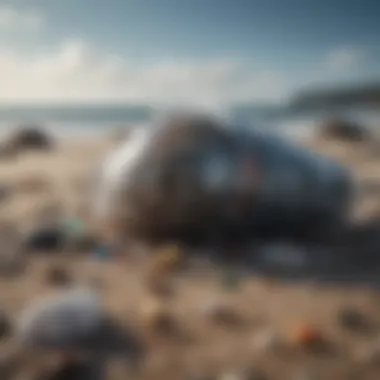
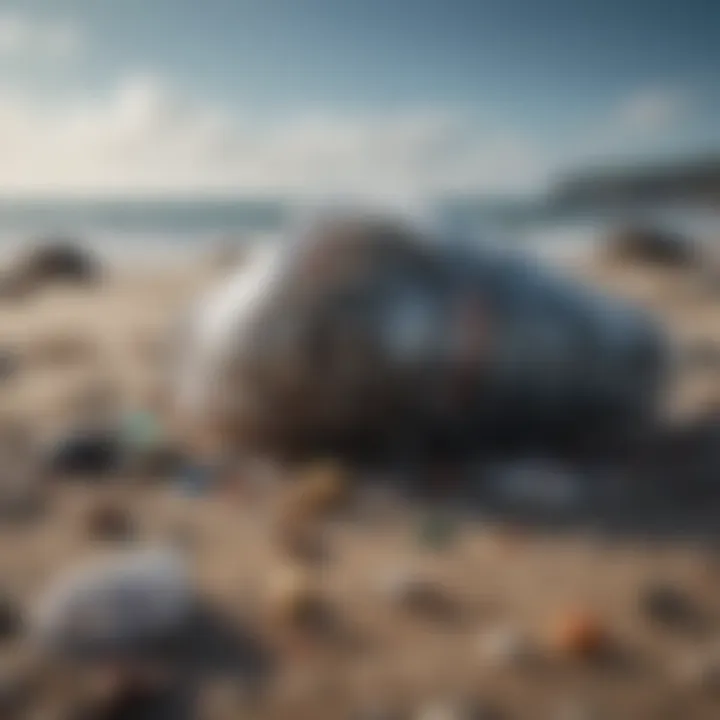
From the perspective of this article, exploring ingestion underscores the importance of addressing plastic waste at the source. It reveals an avenue through which human activity can significantly disrupt marine life. The unique feature here is the accumulative effect—as smaller fish consume microplastics, they are eaten by larger fish, leading to bioaccumulation up the food chain, posing threats to predators, including humans.
Entanglement
Entanglement is another grave consequence of marine litter, particularly with discarded fishing gear and plastic debris. Many marine animals, such as turtles and seals, get caught up in nets or six-pack rings, severely impairing their ability to move and feed. The key characteristic of entanglement is its immediate visibility; unlike ingestion, which often occurs unseen, entanglement leads to tangible suffering.
This form of impact illustrates the need for proper waste disposal and gear recycling among fishing communities. The unique aspect of entanglement is the observable nature of these incidents; signs of struggle are often visible, prompting urgent response efforts. While some interventions can help freed animals, not all are so fortunate, driving home the cruelty inherent in this issue.
Threats to Human Health
Bioaccumulation
Bioaccumulation refers to the process by which harmful substances, such as heavy metals from marine litter, build up in living organisms. This specific concern is critical as contaminants can persist in the environment, entering the food chain. For humans who consume seafood, this translates to direct exposure to toxins, raising concerns about long-term health implications. Studies have linked accumulation of heavy metals to neurological disorders, reproductive issues, and an array of chronic diseases.
The unique feature of bioaccumulation is that it highlights the interconnectivity between our ecosystems and human health. In the context of this article, emphasizing this process serves to stress the importance of monitoring pollutants and regulating waste management practices.
Water Quality
Water quality is increasingly jeopardized by marine litter. Pollution from plastics and other materials can degrade the aesthetic, chemical, and biological qualities of ocean waters. Nutrient run-off mixed with stranded debris encourages algal blooms, which can lead to dead zones where aquatic life cannot survive. The significance of surpassing mere aesthetics cannot be overstated; deteriorating water quality poses a substantial threat to ecosystems and public health alike. Suffice it to say, balanced water quality is foundational to both marine biodiversity and human usability of oceans.
The unique aspect of this issue is the holistic approach needed to tackle it—there’s a clear crossover between environmental stewardship and public health initiatives. By improving water quality, we can bolster ecosystem resilience and reduce health risks, making it a choice effort in driving the mission of this article.
Regional Perspectives on Marine Litter
Understanding marine litter necessitates a dive into the unique scenarios presented by different regions of the world. Each area gives rise to distinct sources and types of marine debris, largely influenced by local practices, policies, and ecological circumstances. The context informs both the challenges these regions face and the potential solutions that can be tailored to address them effectively. By examining these diverse perspectives, the article aims to spur localized awareness and action, recognizing that a one-size-fits-all approach to combating marine litter simply won't cut it.
Coastal Areas
Coastal areas often bear the brunt of marine litter. These regions, where land meets sea, serve as hotspots for debris accumulation largely due to human activity. Urban runoff, tourism, and waste disposal practices contribute significantly to this accumulation. According to recent studies, nearly 80% of marine litter originates from land-based sources. Coastal communities can experience a multitude of consequences from this debris, far beyond just unsightly beaches. Ingesting microplastics, for instance, can have devastating effects on local fish populations, threatening food sources for both wildlife and humans.
In such regions, community engagement is vital. Local cleanup initiatives often emerge out of recognition by residents of the issues presented by marine litter. These efforts, while grassroots in nature, can lead to broader legislative changes when combined with advocacy. The focus should also be on fostering public awareness around waste handling and recycling, which can further mitigate marine pollution.
High Seas
The high seas present a different challenge altogether. The vast, open waters are often perceived as far removed from human influence, resulting in less attention and regulation. This is somewhat misleading, as fishing activities contribute significantly to litter in these regions. Lost or discarded fishing gear, known as ghost nets, constitute a serious hazard. These nets not only entangle marine life but also lead to further degradation of the ecosystem.
Moreover, ships traveling through these waters can inadvertently contribute to litter through littered waste and even discharge practices. With international maritime laws, like MARPOL, in place, there's a glimmer of hope for managing waste from ships. Nonetheless, enforcement remains a gray area, often making compliance optional. One could argue that better detection technologies and tracking systems are needed to ensure accountability for waste disposal at sea.
Polar Regions
The polar regions, while remote and less populated, are not immune to the encroachment of marine litter. Surprisingly, they too are seeing an uptick in debris, often transported by ocean currents from more heavily polluted areas. The implications here are profound, as these ecosystems are incredibly sensitive. Wildlife in these areas are particularly vulnerable, with species like seals and polar bears at risk from ingesting plastics and other debris.
In addition, research expeditions and tourism can introduce more waste to these pristine environments. With climate change also affecting currents and ice dynamics, the risk of marine litter becoming permanently embedded in these ecosystems is particularly concerning. Addressing these issues might require international collaboration, especially in regions like the Arctic, where jurisdiction is murky. A shared commitment to protection, legislation, and sustained research is critical for safeguarding these vulnerable areas.
"If we understand the unique challenges faced by each region, we can craft targeted responses that not only address marine litter but also uphold the ecological integrity of irreplaceable marine environments."
By emphasizing these regional perspectives, it becomes clear that collective action is necessary, tailored toward the specific circumstances and challenges each area faces. This targeted approach could yield more effective and sustainable outcomes in the ongoing battle against marine litter.
Legislative Frameworks
Understanding the legislative frameworks surrounding marine litter is crucial for fostering effective change. Laws and international agreements serve as the backbone for any efforts aimed at mitigating marine litter. They provide a structure to harmonize national policies, facilitating cooperation among different regions. Moreover, they set out penalties for non-compliance, ensuring that responsible parties are held accountable. Such frameworks offer a multifaceted approach, enhancing the public's awareness and the policy actions necessary to combat the litter crisis.
International Agreements
MARPOL
MARPOL, formally known as the International Convention for the Prevention of Pollution from Ships, plays a pivotal role in regulating marine pollution. One key aspect of MARPOL is its focus on minimizing waste from ships at sea. This international treaty sets strict guidelines on what kinds of waste can be disposed of into the ocean and under what conditions.
One of the hallmarks of MARPOL is its comprehensive structure. It combines numerous protocols aimed at curbing oil spills, sewage disposal, and garbage management in marine environments. This makes it a popular choice for stakeholders aiming to address marine litter comprehensively. However, a unique feature of MARPOL that often gets overlooked is its reliance on “port state control.” This regulation allows countries to enforce laws even against foreign ships at their docks, thereby extending the reach of these rules.
Yet, the favorable aspects of MARPOL do not come without their drawbacks. Some critics argue that the enforcement of MARPOL regulations can be uneven, particularly in countries with limited resources to monitor compliance. This inconsistency can hinder its effectiveness as a global solution.
OSPAR Convention
The OSPAR Convention focuses predominantly on the protection of the North-East Atlantic, addressing challenges posed by pollutants and environmental degradation. Its specific commitment to tackle marine litter aligns well with the goals of this article. A key characteristic of the OSPAR Convention is the collaborative approach it fosters among member states to monitor and manage marine litter effectively.
One of the unique features of OSPAR is its use of a common monitoring program which enables the member countries to share data and strategies effectively. This comprehensive data flow allows for better-informed decision-making. Furthermore, OSPAR’s framework allows for adaptive management, meaning that it can evolve in response to scientific advances and emerging threats.
However, OSPAR isn’t without its critics. Sometimes viewed as being overly bureaucratic, there are concerns that the lengthy processes involved in decision-making might delay necessary actions. But despite this, its commitment to integrated coastal management provides a much-needed balance between environmental sustainability and economic interests.
National Regulations
National regulations play a crucial role in complementing international agreements and make it easier for local communities to take action against marine litter. Different countries implement various strategies tailored to their unique challenges and capabilities. Common approaches include stricter waste management practices, improved sewage treatment, and public awareness campaigns.
National regulations often have the flexibility to adapt to regional issues, which can enhance their effectiveness. For instance, some nations have specific laws targeting plastic bags or straws, coupled with educational outreach designed to alter consumer behavior. This localized focus ensures that solutions are relevant and actionable.
Overall, the role of legislative frameworks in tackling marine litter cannot be overstated. They create an aligned approach that not only brings together very different stakeholders but also keeps them accountable—helping to pave the way for cleaner oceans.
Innovative Solutions and Technologies
The growing concern over marine litter calls for out-of-the-box thinking and innovative solutions. As we peel back the layers of this complex issue, technology and forward-looking practices emerge as essential components in the fight against debris choking our oceans. We stand at a crossroads where traditional waste management approaches must evolve to address the unique challenges posed by marine litter.
In this vein, it is crucial to delve into specific elements that contribute to effective solutions, evaluating the benefits they bring, and the considerations that come along the way.
Waste Management Technologies
One of the fundamental pillars to combat marine litter is sophisticated waste management technologies. Simple roadmaps won't cut it anymore; we need smart, robust systems that seamlessly minimize litter before it ever sets foot in our precious waters. Here are notable developments:
- Automated Sorting: Advances in technology allow waste management facilities to implement automated sorting systems that efficiently classify items based on material types. This ensures that recyclables are diverted from landfills effectively.
- Smart Bin Systems: Innovations like bins equipped with sensors can notify waste collection services when full. This prevents overflow and potential littering, especially in high-traffic areas.
- Waste-to-Energy: Techniques that convert waste into energy help reduce the volume of refuse heading toward incineration or landfills. By harnessing waste's potential, we not only cut down on debris but also contribute to cleaner energy sources.
The beauty of these technologies lies in their multifaceted benefits. They not only mitigate the flow of waste entering marine environments but also promote sustainable resource management.
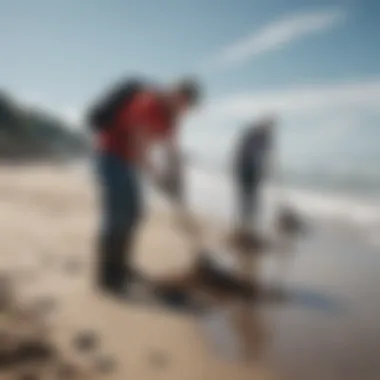

Ocean Cleanup Initiatives
When we think of tackling marine litter, several initiatives have taken root, striving to clear our waters effectively. Some innovative solutions include:
- Net Collectors: Large-scale floating barriers, such as those used by The Ocean Cleanup project, gather plastics that drift in the ocean. These passive systems necessitate minimal human intervention while effectively accumulating waste.
- Drones for Identification: High-tech drones equipped with cameras scan vast ocean expanses to locate litter hotspots. By utilizing aerial perspectives, organizations can deploy cleanup operations more efficiently.
- Community Engagement Programs: Engaging local communities not only fosters marine stewardship but also equips routine cleanups with adequate resources, making it easier to mobilize efforts in frequently littered areas.
In essence, these initiatives harness both technology and community spirit, leading to cleaner shores and healthier oceans. However, these solutions are not without their challenges, such as funding, regulatory burdens, and the sheer scale of the issue.
Biodegradable Materials
The push for alternatives to traditional plastics has never been more vital. Research in biodegradable materials presents promising avenues to mitigate marine litter. Here’s what’s being explored:
- Plant-Based Plastics: Derived from renewable resources, these materials can ensure a certain level of biodegradability. Products like polylactic acid (PLA) are derived from cornstarch and break down over time, unlike conventional plastics.
- Natural Fiber Packaging: Replacing conventional packaging with options made from hemp or jute can reduce dependency on non-biodegradable substances. These materials decompose naturally and leave little to no lasting footprint.
- Innovative Products: Biodegradable versions of everyday items, like straws or cutlery, present a more eco-friendly option. Their production and disposal mean less plastic in marine environments.
Ultimately, as the tide turns toward sustainability, embracing biodegradable alternatives can sculpt a future with less reliance on harmful materials, ultimately leading to cleaner oceans.
"Innovative materials and technologies represent a beacon of hope in the struggle against marine litter. However, the success of these alternatives hinges on public awareness and policy support."
Regardless of the innovation, it is imperative that these solutions be complemented by robust public engagement and actionable policies to manifest an effective response to the marine litter crisis.
Public Awareness and Education
Raising public awareness about marine litter can be likened to lighting the lamp in a dark room; without it, the true extent of the issue often remains hidden. Understanding how litter affects both marine ecosystems and human society is crucial for fostering a sense of responsibility and action among individuals and communities alike. Public awareness and education lay the foundation for effective interventions against marine pollution. They remind us that the ocean is not just a distant body of water; it’s a vital resource intertwined with our daily lives.
Education programs should aim to instill a sense of stewardship among the public, highlighting that every small action counts toward a larger impact. As awareness grows, so does the collective force for advocacy and change.
One of the key benefits of public awareness initiatives is that they can transform perceptions about litter and waste. This is sorely needed, as many people still view litter as a minor nuisance rather than an environmental crisis. When individuals see their personal connection to the oceans and understand the broader implications of litter, they are often more likely to participate in local clean-up activities or support legislation aimed at reducing plastics and other pollutants.
Additionally, creating a culture of awareness encourages sustainable practices. People may start opting for reusable bags, proper sorting of recyclables, and actively participating in community discussions about waste management solutions.
"The ocean is a reflection of our actions on land; nurture it, and it thrives. Neglect it, and we all suffer."
Overall, fostering public awareness around marine litter is not a standalone effort. It needs to be integrated into educational frameworks that grab attention and evoke emotions. The next step is diving deeper into the role of community involvement.
Community Involvement
Community involvement plays a vital role in combating marine litter. It is where individuals take ownership of their local ecosystem and engage actively with related issues. When communities rally behind the cause, their collective energy creates a ripple effect, impacting areas far beyond their immediate surroundings.
- Local Clean-Up Events: Organizing beach or river clean-up days is an excellent way for communities to come together. Not only does this keep their environments cleaner, but it also serves as an educational platform where residents can learn about types of marine litter and their impacts.
- Partnerships with Local Businesses: Engaging businesses to support clean-up efforts or educational campaigns can amplify the message. For example, when a local café partners with a clean-up event, it reinforces their commitment to sustainability while attracting socially conscious customers.
- Social Media Campaigns: Using platforms like Facebook and Reddit can also boost community involvement. An online group dedicated to discussing marine litter can mobilize support quickly and push for action, turning awareness into measurable outcomes.
Effective public outreach relies on fostering community bonds. When people feel interconnected through shared goals—like cleaning up a local beach—they’re more likely to remain committed to the cause.
Educational Programs
Educational programs aimed at different age groups can dramatically influence public understanding of marine litter. Tailoring content to various demographics can maximize engagement and effectiveness. For instance, school programs can be adopted while adult workshops can focus on practical solutions and policy advocacy.
- School Curriculum Integration: Including marine ecology and conservation topics in school curriculums not only educates children about marine litter but also promotes a culture of responsibility from a young age. Children can learn about the effects of plastic on marine life and subsequently become advocates for clean oceans in their homes and communities.
- Workshops for Adults: Hosting community workshops on waste management and ecological practices invites adults to contribute their ingenuity in crafting solutions. This can spark lively discussions about how to tackle local recycling issues or reduce single-use plastics.
- Interactive Digital Platforms: Using platforms like en.wikipedia.org to share informative articles or creating quizzes to test knowledge on marine debris can be engaging and insightful.
The key is to make educational initiatives both informative and actionable, allowing participants to see how they can make a difference in their own lives. Every effort contributes to a growing wave of change aimed at tackling this unseen crisis in our oceans.
Future Research Directions
In the quest to tackle marine litter effectively, pinpointing the future directions for research becomes paramount. This section sheds light on the necessary inquiries, assesses current practices, and underscores how increased attention to marine litter can translate into substantive environmental benefits.
Gaps in Current Knowledge
One of the foremost aspects demanding attention is the plethora of gaps in current knowledge about marine litter. There’s a noticeable lack of comprehensive data regarding the quantities and types of litter dispersed across various marine environments. While studies have documented the presence of plastic debris, there's much less information about other materials like organic waste or chemicals. Furthermore, researchers often struggle to identify the ultimate fate of these materials once they enter the ocean.
- Complex Interactions: How marine litter interacts with other pollutants or natural elements remains an enigma. For instance, when microplastics absorb toxic chemicals, what happens when they’re consumed by marine life?
- Regional Variations: Different geographical areas exhibit unique patterns of pollution, but research has disproportionately centered on certain populations and neglects others. Filling these knowledge gaps can provide a holistic understanding of marine litter's severity worldwide, uncovering alarming trends before they spiral out of control.
Additionally, many studies focus on immediate effects, neglecting the long-term ecological consequences. Understanding the chronic impacts on ecosystems and food webs is essential if we hope to devise effective management strategies.
Interdisciplinary Approaches
As the saying goes, two heads are better than one, and this rings especially true in the context of marine litter research. Embracing interdisciplinary approaches can yield groundbreaking insights and practical solutions. Collaboration across fields such as oceanography, environmental science, policy-making, and even social sciences can enrich our understanding and tackle this crisis more effectively.
- Technological Advances: Combining knowledge from engineering and environmental science could lead to the development of innovative solutions, like improved biodegradable materials or advanced waste management technologies. For instance, innovative robotic systems could be utilized for cleaning beaches or monitoring waste accumulation.
- Public Engagement: Social scientists can offer valuable perspectives on public behaviors and perceptions regarding marine litter. Understanding what drives human actions might unveil strategies for shifting consumer habits and increasing support for cleaner oceans.
- Policy Development: Researchers can work alongside policymakers to create frameworks that not only generate incentives for reducing litter but also hold corporations accountable for their environmental footprints. This cross-disciplinary collaboration can shape impactful regulations and educational initiatives to foster a culture of sustainability.
By diversifying the lenses through which we examine marine litter, we pave the way for comprehensive solutions that ultimatley protect marine ecosystems and by extension, our very own health and prosperity.
"An interdisciplinary approach is not just beneficial for marine litter research; it's foundational for crafting strategies that will endure and meet ecological challenges head-on."
In summary, addressing the gaps in knowledge and fostering interdisciplinary collaborations can lead scientists and policymakers toward a future where marine litter is managed effectively and responsibly. This is not merely a call for more research; it’s a mandate for transformative change that draws wisdom from varied domains to ensure a sustainable marine environment.
Culmination and Call to Action
As we draw this comprehensive exploration to a close, it’s essential to underscore the urgency of addressing the issue of marine litter. This pervasive problem is much more than just an environmental concern; it intertwines with our health, economies, and the well-being of ecosystems. It's not just the marine life that’s ensnared in this crisis – we too, are caught in its net, facing repercussions in our daily lives and surroundings.
Summary of Findings
Throughout our discussion, key findings emerge starkly, highlighting the extensive reach of marine litter:
- Diverse Sources: Marine litter originates from varied sources, both on land and at sea. Urban runoff, inefficient waste management, and activities in the shipping and fishing industries significantly contribute to the problem.
- Ecosystem Impacts: The data reveals that marine litter has dire implications for ecosystems, impacting species diversity and disrupting habitats. Once debris enters marine environments, it becomes a long-lasting pollutant.
- Human Health Risks: The absorption of harmful chemicals into the food chain poses a significant risk. Marine organisms, upon ingestion of litter, face bioaccumulation of toxins, which can eventually reach human consumers.
The insights gathered here should serve as a clarion call for collective action. A problem of this magnitude cannot be solved in isolation.
The Path Forward
Finding solutions to the marine litter crisis requires a multi-faceted approach:
- Policy Frameworks: Stronger, more comprehensive regulations must be enacted at local, national, and international levels. Legislation should target the most significant sources of marine debris, leading to mindful practices in waste disposal and management.
- Public Engagement: Changing public perception is key. Educational programs should be catalyzed in schools and communities, cultivating awareness about marine litter and its consequences.
- Innovative Collaborations: Partnerships between governments, NGOs, and private sectors can yield new technologies and novel solutions. For instance, initiatives like The Ocean Cleanup have exemplified how effective innovation can play a role in tackling this pressing issue.
- Research Investment: Funding future research is pivotal to uncovering gaps in knowledge and methodologies. Interdisciplinary approaches integrating marine biology, environmental science, and policy studies will lead to comprehensive strategies in combatting marine litter.
Ultimately, the responsibility lies with us all; from educators to policymakers to everyday citizens. By understanding the implications and acting collectively, we can pave a path toward clearer and healthier marine environments. Let's act now to ensure our oceans can thrive for future generations.
"The seas are not just a resource; they are a reflection of our choices. Let us choose wisely."
Every small action matters. Whether it’s participating in local cleanup drives or advocating for better waste management policies, contributions to this cause are vital. Now is the time to take these insights and transform them into action – to protect the sanctity of our oceans, making them cleaner and safer for all.







